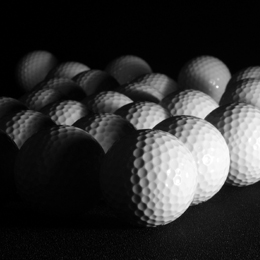 |
| Photo Credit: Randal Dean |
What makes golf balls different?
There are several attributes that affect a golf ball's performance and style of play. The most important ones are:
- Compression Rating
- Number of Layers
- Dimple Design
- Cover Thickness
Those four attributes greatly affect how a ball behaves. The combination of those factors determines a ball's feel, trajectory, spin and distance. To find your perfect ball, you must understand each of those attributes.
Compression rating: Compression measures how much a ball flattens on impact. The higher the compression rating, the farther it will travel (Mulvoy). However, to utilize higher compression ratings you must have an all-around good swing. If you swing like a professional or a good amateur, you can use 100-compression balls, but if you are like most golfers, you should use a ball with a compression rating around 90 (Mulvoy).
Number of Layers: Most golf balls used today have a two- or three-layer construction. Wound balls have been replaced by more advanced technology. Typically, two-piece balls are harder and designed for beginner players. The extra hardness increases the ball's distance but lessens its feel and spin. Neither feel nor spin are critical for beginners (World Book). Professionals and low handicap players usually prefer the softer, three-layer golf balls. The three-layer design gives them extra control and feel at the expense of distance (Wright).
Dimples Design: The shape, size and depth of golf balls' dimples significantly affect their trajectories. Although most modern golf balls are designed to improve distance and accuracy, subtle dimple variations exist between golf balls that affect performance. Designs with shallow and larger dimples have more loft, traveling higher in the air. Designs with deeper and smaller dimples travel farther and lower. If you have to choose just one ball, it's better to use one with deeper, smaller dimples because it is less likely to be caught in the wind due to its lower flight path (Mulvoy).
Cover Thickness: The thickness of the outside cover affects both a golf ball's durability and how it performs. In general, thicker covers result in extra durability, longer distance and less spin, which makes them fade and draw less (Mulvoy). However, golf balls with thicker covers have reduced backspin, making it difficult to stop the ball on the green like the pros (Morelli).
Which golf balls should you use?
To find the perfect golf ball for your swing, you have to tryout several different types until you find one that feels good and performs well with your equipment and swing (Morelli). However, there are some general guidelines that can narrow the field. It would be impossible to try every golf ball on the market.
Beginner: If you are just starting out, buy the cheapest balls you can find. You will loose a lot of them, and until you can consistently hit the ball straight you won't be able to benefit from the enhancements of expensive balls (Wright). The money you save on golf balls is money that is better spent on lessons or practice rounds. Two-piece balls are good beginner balls because they are the least expensive, boost your distance and often have less spin, which helps reduce the ill effects of hooks and slices (World Book).
Intermediate: If you can consistently hit the ball straight and keep it on the fairway, you can invest a little more in your golf balls. A standard three-layered ball will be your best bet (Dobbins). Though not the highest quality, the soft feel will allow you to produce more spin, enabling you to shape and control your shots. Though you loose a little distance, you get accuracy and workability. The price for those balls is more than the two-layer modes but less than high performance balls.
Advanced: Professionals and low-handicap golfers usually prefer superior feel and control rather than distance (Wright). If you are looking for precision and workability, use a high performance three-layered ball. They are softer and less durable, which means you get less distance, and the balls won't last as long. However, for an expert player, the control and spin are well worth the high price (Dobbins).
No one golf ball fits all golfers. However there is a type of ball that is right for you. Once you narrow the field to a few golf balls, try them out. The one that feels the best and performs the best is the one to keep. Also, as your game progresses, don't be afraid to change golf balls. Just as you outgrow your beginner clubs, you can easily outgrow your beginner golf balls.